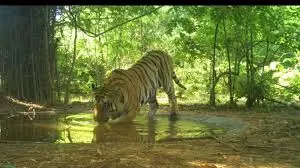Indian Gaur to find new home in Nallamala

Nagarjunasagar-Srisailam Tiger Reserve (NSTR). (Image: DC)
Kurnool: The Nagarjunasagar-Srisailam Tiger Reserve (NSTR) is preparing to re-introduce the Indian Gaur (Adavi Dunna) following positive feedback to a feasibility study conducted by the Wildlife Institute of India (WII). Authorities are currently planning to relocate these animals from Papikonda National Park or other suitable locations within the state.
Forest officers first spotted pug marks of the Indian Gaur during the summer. After tracking these signs for several weeks, they confirmed the presence of the animal. Initially observed in January, the Indian Gaur has been moving through the area for the past four to five months. Visitors on jungle safaris reported sightings of the animal in the Velugodu range in January, sharing their experiences on social media. By July, officials confirmed its presence in the Bairluty range within the Atmakur division.
Following these sightings, officials collaborated with the Wildlife Institute of India to conduct a feasibility study, assessing the region's suitability for the re-introduction of the Indian Gaur. The study indicated the Nallamala forest environment is conducive to the animal's well-being.
G. Vignesh Appavu, deputy director of forests in Markapuram, stated, “We are now implementing a project focused on the Indian Gaur based on the WII's recommendations. We plan to protect these animals within the tiger reserve as well.”
Forest officials said the gaur is a social animal, typically living in groups of 30 to 40 and primarily feeding on vegetation. The Indian Gaur has been listed as vulnerable by the International Union for Conservation of Nature since 1986, due to its declining population numbers. Additionally, the Indian government has included the protection of the wild bison/gaur in schedule I of the Wildlife Protection Act, 1972.
Recently, another herd consisting of two-three animals — a male, a female, and a cub — were spotted in the Giddalur area. The movements of the Indian gaur observed in January, July and the ongoing presence of the animal suggest that they are finding safe and convenient habitats within the reserve.
( Source : Deccan Chronicle )
Next Story

